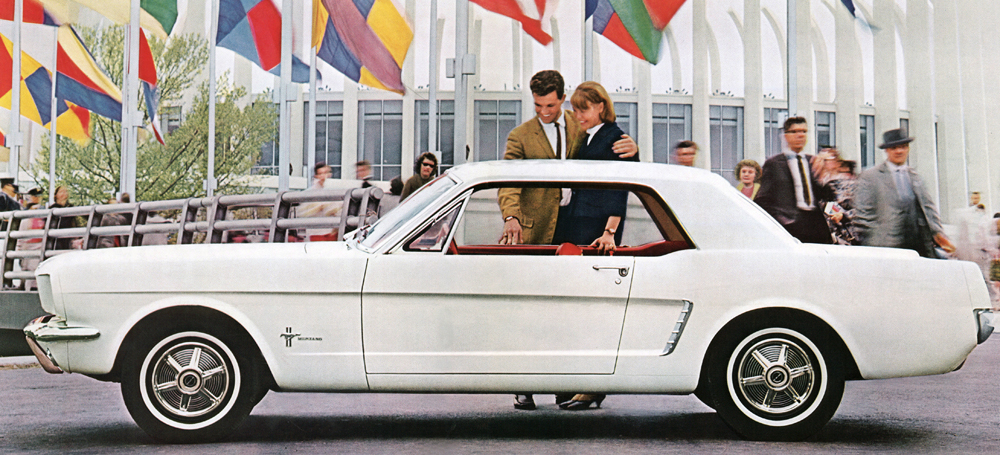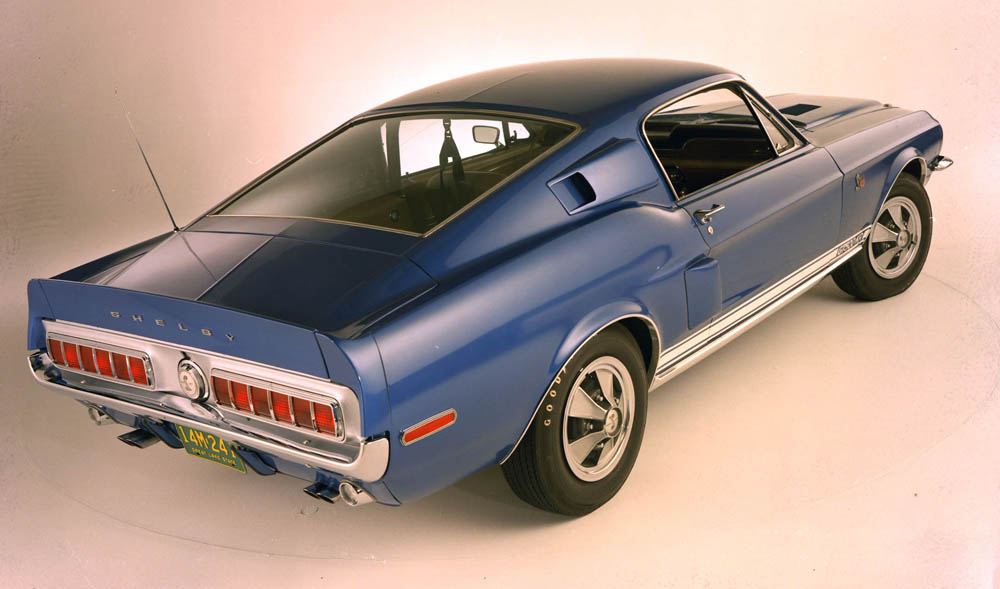
Generation I: 1964 ½ – 1973
1964: The world debut of Mustang occurred at the 1964 World’s Fair in Flushing Meadows, New York on April 17, 1964. Standard equipment includes a 170-cubic-inch (cid) six-cylinder engine, three-speed floor-shift transmission, full wheel covers, padded dash, bucket seats and carpeting. It weighed just 2,572 pounds. The price at launch: $2,368.
Mustang unveiling at the 1964 New York World’s Fair
At the car’s launch, the company expected annual sales of about 100,000 units. But 22,000 Mustang orders were taken on the first day, and sales reached an astounding 417,000 in car’s first 12 months.
The first regular production Mustang was a Wimbledon White convertible with a 260-cid V-8 that rolled off the assembly line on March 9, 1964. While on a promotional tour of Canada, a Ford dealer in St. John’s, Newfoundland “mistakenly” sold the car to Capt. Stanley Tucker, a pilot with Eastern Provincial Airlines. Ford reacquired the car from Capt. Tucker in 1966 in exchange for Mustang number 1,000,001, and the original car is now on display at The Henry Ford in Dearborn, Mich.
1965: The Shelby GT350 is introduced, with its 306-horesepower (hp), 289-cid V-8.
1966: Mustang sales pass the one million mark in March. A 1966 Mustang is the first – and perhaps only car to park on the 86th floor observation deck of New York’s Empire State Building. In October 1965, Ford engineers disassembled a 1966 Mustang convertible and took it up in four sections using the building’s passenger elevators.
Ford Mustang on top of Empire State Building
1967: The 1967 model is considered by many to be the high water mark for Mustang design in the 1960s. The 2+2 model goes from a semi-notchback to a sweeping full fastback roofline. Separate triple tail lamps, a longer nose and a bigger grille also are added for a more aggressive stance.
The Shelby GT500 goes on sale, powered by a massive 428-cid V-8 that produces 355 hp.
1968: The 302-cid V-8 replaces the “289” midyear, and a medium-riser version of Ford’s premier race engine, the 427-cid V-8 (rated at 390 hp), is offered as a $622 option. On April 1st, the 428 Cobra Jet engine is introduced as part of an option package aimed at enthusiasts.
1969: A “steed for every need” philosophy yields 11 different powertrain combinations. New models added to the lineup include the 290-hp Boss 302, the 375-hp Boss 429, the Mach 1 and the Grande luxury model. Also offered for the first time is the 351-cid “Windsor” V-8 engine, producing 250 hp with a two-barrel carburetor, or 290 hp with a four-barrel.
1970: A ram air “Shaker” hood scoop can be ordered on any Mustang equipped with a 351-cid or larger V-8.
1971: The 1971 cars are the biggest Mustangs ever — nearly a foot longer and some 600 pounds heavier than the originals. Gone from the lineup are the Boss 302, Boss 429, Shelby GT350 and GT500. The Boss 351, with its 351 “Cleveland” V-8 and Cobra Jet heads, debuts. The Mach 1 is available with a variety of powertrains, topped by the 370-hp 429 SCJ (Super Cobra Jet).
1972: Styling is unchanged from 1971, and the only new model offering is the Sprint – a special red, white and blue exterior paint-and-tape package with coordinated interior.
1973: The impact of gasoline shortages, rising insurance premiums and emissions controls brings the muscle-car era to a close. The 1973 model year is the last for the original Falcon-platform Mustang. The convertible is discontinued.

THE GREAT MUSTANG DEBATE: 1964½ OR 1965?
Ever since the debut of the original Ford Mustang, there has been an ongoing debate about what to call the pony cars built between April and August of 1964. Are they “1964½” Mustangs or 1965 models?
Technically, all of the original Ford Mustangs are 1965 models because all carry a 1965 model year Vehicle Identification Number (VIN).
But the majority of Mustang enthusiasts throughout the world are purists at heart, and they know very well that the vehicles produced from April to August of 1964 were different enough from those manufactured during the remainder of the model year to warrant giving them another name.
“An entire generation has grown up calling these vehicles ‘1964½.’ It is part of the lexicon of Mustang history,” said John Clor, author of The Mustang Dynasty. “Technically, all of the original Mustangs are 1965 models, but true enthusiasts know that production of the car ran for a year and a half and that the car changed after the first six months.”
The biggest change was in the electrical system. The so-called 1964½ Mustangs used generators while those made during the standard 12-month 1965 model year used alternators. Also, the V-8 option was different. The 1964½ models used the 260-cubic inch V-8 engine, while the 1965 models employed a 289-cubic inch V-8 engine.
“People like to say there is no such thing as a 1964½ Mustang, and in theory they are correct,” said Charles Turner, national head judge for the Mustang Club of America (MCA). “But there is a wide range of little differences between the cars built before and after August of 1964 that make them very unique. The MCA accepts the 1964½ as a model year because we view it as a different car.”
Those lucky enough to own a Mustang built between April and August of 1964 view their pony cars as a totally different breed of the steed.
“We take exception to someone calling them 1965 Mustangs because the ’64½ was a unique car when it was introduced, and it is a very special thing to own one,” said Fred Glazier, who bought his Rangoon Red Mustang coupe in May of 1964. “When you tell someone you have a 1964½ Mustang, people who understand Mustangs know what you’re talking about.”
First generation Mustang Facts
- The original Ford Mustang debuted on April 17, 1964 at a price of $2,368 – a bargain even at that time.
- Dealers were inundated with requests for the vehicle. In Garland, Texas, 15 customers bid on the same Mustang, and the winner insisted on sleeping in the car overnight to guarantee that it wouldn’t get sold from under him before his check cleared the next day.
- Ford expected annual sales of about 100,000 units, but 22,000 Mustang orders were taken on the first day, and sales reached an astounding 417,000 in the car’s first 12 months on the market.
- Not much more than a month after its introduction, Ford’s new Mustang was on the racetrack as the pace car for the 1964 Indianapolis 500 race.
- The early Mustangs have figured prominently in hundreds of notable films to date, beginning in 1964 with the James Bond movie Goldfinger, in which Bond’s Aston Martin DB5 chased a white Mustang convertible.
- Mustang-crazed parents bought 93,000 pedal-powered children’s Mustangs during the 1964 Christmas season.
- In 1965, the Shelby GT350 was introduced, with a 306 horsepower V-8 engine, giving the Mustang performance credibility.
- Mustang sales passed the one million mark in March of 1966. The 1966 Mustang was the first – and perhaps the only – car to park on the 86th floor observation deck of New York’s Empire State Building. Ford engineers disassembled a 1966 Mustang convertible and took it up in four sections using the building’s passenger elevators.
- Mustang-mania hit full force. The 289-cid V-8 “Hi-Po” engine became available. Carroll Shelby adapted the Shelby GT350 for Sports Car Club of America (SCCA) competition, and the GT350 went on to win three straight SCCA national championships.
- The 1967 Mustang was considered by many to be the high water mark for Mustang design in the 1960s. The 2+2 model went from a semi-notchback to a sweeping full fastback roofline. Separate triple tail lamps, a longer nose and a bigger grille made for a more aggressive stance.
- In 1968, the 428 Cobra Jet engine was introduced as part of an option package aimed at enthusiasts, and it helped make the Shelby GT500 become King of the Road – KR.
- A “steed for every need” philosophy yielded 11 different powertrain combinations in 1969. New models added to the lineup included hot rods like the 290 horsepower Boss 302, the 375 horsepower Boss 429 and the Mach 1, giving the Mustang its muscle car heritage. The Grande luxury model also was introduced.
- In 1970, a ram air “Shaker” hood scoop could be ordered on any Mustang equipped with a 351-cid or larger V-8.
- The 1971 Mustangs were the biggest Mustangs ever – nearly a foot longer and some 600 pounds heavier than the originals. The Boss 351, with its 351 “Cleveland” V-8 and Cobra Jet heads, debuted. The Mach 1 was available with a variety of powertrains, topped by the 370 horsepower 429 Super Cobra Jet.
- In 1973, the impact of gasoline shortages, rising insurance premiums and emissions controls brought the muscle car era to a close. The 1973 model was the last original Falcon-platform Mustang, and the convertible model was discontinued.


You must be logged in to post a comment.